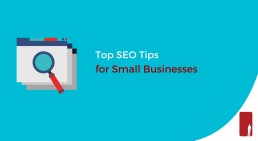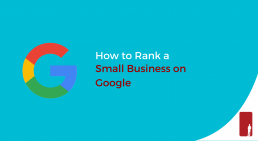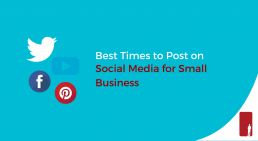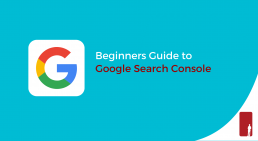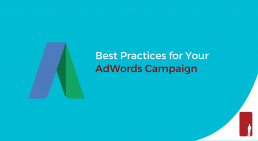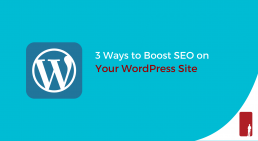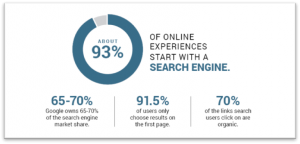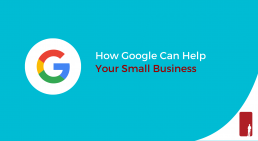Top SEO Tips for Small Businesses
If you are a small business looking to be found on search engines, you can create a checklist to make sure everything is perfect for your next website article. This SEO checklist won’t protect you from crashing and burning, but it’ll help ensure that you have the best chance to rank high in Google.

Here are the top SEO tips for small businesses:
1. Choose a good keyword
Say your business provides drain repair services like Draintony, you’ll want to find out what people are actually searching for. Your first step should be choosing a good keyword you want to show up for.
Google Keyword Planner is a free tool that will help you choose a good keyword by showing an estimate for any search phrase. You might need to set up an AdWords account to gain access to Keyword Planner. For example, when you type in drain repair in Keyword Planner, you’ll notice that “drain repair” receives 210 monthly searches in Toronto.
Click here to read more about the tools Google has available to help your small business.
2. Research your competition
So now that you have a keyword you want to try and rank for, you’ll want to go undercover and research your competition. Start by going on “private browsing” mode on your web browser and head to Google.com. Going on private browsing mode won’t allow Google to use your past search history to influence what you see on the search results page. Ignore any ad results at the top and look at the content on page one of Google. The results on the first page are your competition.
3. Write the best content
You have your keyword, you research your competition, now it’s time to write the best content. Whether you’re creating a web page, blog post, landing page, or an e-commerce store page, it needs to be better than your competition.
4. Put the keyword in your page title
Finished writing the best content possible? You sure it’s going to be better than your competition? Your next step is to put the keyword you’ve chosen on your page title. It doesn’t necessarily have to be the exact phrase, but it can be if you like. You want to make the title interesting enough so people will actually want to click on it. Think of a title that will make people say “Now that is something I would want to read!”
5. Put the keyword in your header
You need to organize your webpage because it’s helpful in showing Google exactly what your blog post is about. Organize your web page by having a large title at the top, followed by several sub-headers through the page. It’s important to use the exact keyword phrase at least once in your sub-headers.
6. Put the keyword in the name and alt-tag of your image
Use images to cement the idea to Google about your post’s topic. There are two ways to do this: the image name and the image alt tag.
Change the name of the image on your computer before uploading it. Re-name the file to something like “drain repair 1.jpg” instead of a generic file name like “12345.jpg.” Then, upload it to your website.
After you upload the image to your website, change the alt tag to a text that will describe the photo just in case the photo can’t load for some reason on a web browser.
Related Article: 3 ways to Boost SEO On Your WordPress Site
7. Use the keyword in the URL and in the post
Another way to help Google determine what your post is about is the URL. You want Google to choose your website when it’s deciding whether or not to show a certain page. For example, which of the following URLs do you think Google will like better?
• www.draintony.com/12345
• www.draintony.com/drain-repair
8. Insert internal links
You should always internally link other pages on your website, especially the ones with your best SEO content.
9. Get external links
External links are from websites other than your own. Google relies on external links to determine how good a post is. Therefore, you‘re going to have to do some link building, which means reaching out to other websites other to ask for links.
Hopefully, these top SEO tips can help your small business when it comes to creating your next website article. If you have any questions, feel free to drop a comment below!
Source: https://www.entrepreneur.com/article/274809
About Retailors Group
The team at Retailors Group has over 15 years of retail sales and field marketing experience. Retailors Group takes the time to understand your brand and align your core values into a tailor-made solution that builds a long-lasting relationship with your consumers.
We offer services in Experiential Field Marketing, On-site Sales Assist, Retail Management, and Digital Marketing.
What is Content Marketing and How Can It Help Your Business?
In a nutshell, Content Marketing is an indirect way of connecting with consumers through materials that do not directly promote a product or service but instead sparks interest and thoughts around products or services that you do sell.
The intended outcome of using Content Marketing would be to gain a new customer but the path at gaining that new customer is very different than your traditional marketing efforts.
If you are able to provide relevant and useful information to consumers that perhaps answers a question or educates them on something that you do, you are taking steps towards showing the public that you are an authority in your industry and a trusted source on that topic. This will give you credibility and increase your audience. Once your audience increases, you will now have a larger and more engaged group of individuals to directly advertise to.
Furthermore, Content Marketing is great for your Search Engine Optimization. The greater content that you produce and share on various platforms, the greater the chances your content will be shared by others, sending positive signals to search engines like Google on how relevant and authoritative your website is.
There are various forms of Content Marketing and we will cover some of them off in this article.
Blog Posts
Posting regular and informative blogs on your company’s website is a great way to educate consumers on your products or services. To really make this work though you should always try to write your blog in a way that answers a question or educates consumers on something that they may have never known.
One of our partners, AWealth, has a very informative blog on Financial Services on their website. Here is one of their blogs on ‘What is an RRSP Loan?’.
As you can see, AWealth wrote this blog to answer a question. At the same time, it also served as an educational piece. The key part about the article was there was no hard sell on getting an RRSP or RRSP loan from them.
Social Posts
Being active on Social Media is perhaps one of the most popular forms of Content Marketing. As of January 2018, Statista reported that Facebook had 2.2 billion active users on its platform! Talk about a wide audience to market to.
The important thing to remember about your posts is to answer a question or to educate. With social media, you can also diversify what you’re posting. Get your customers involved with sharing their photos of them using your product or service. Share other companies or individual blogs that relate to your business on your social site. You can even use this opportunity to showcase pictures of your product or your service in action.
Our partner, Bamboo Legend, does a great job with content marketing on their Instagram account. Their posts showcase their mouth-savouring food but they also take an opportunity to educate the masses on Thai culture.
Infographics
Infographics are graphic visual representations of data or information that are intended to present complex information quickly and clearly. (source: TheNextWeb)
Pinterest is a popular platform where infographics are commonly used. We’ve posted some infographics on our Pinterest page to quickly summarize some of our blogs in a more visual manner.
Infographics can also be used nicely within your website to visually show steps or processes that your company uses to get work done. They can also be used within your blogs to better explain detailed points within your article.
Do you have a lot of statistics that you want to better explain to your audience? Infographics will definitely be your best form to represent that.
Other Forms of Content Marketing
Videos are another great form of Content Marketing. There are 1.5 billion active YouTube users in the world. Video is steadily becoming the most served up content on the Internet. Google searches commonly show video results on a lot of question-based queries and Facebook also gives greater organic reach on videos.
In the spirit of answering questions and educating users, consider adding a ‘How-To’ section on your website. How-To guides are another form of Content Marketing and are sure to draw a lot of attention giving you once again more authority as a subject matter expert. Mix in some of the suggestions in this article like infographics and videos.
Putting together case studies on previous projects is another way you can indirectly promote your company. Give visitors real-life examples of how your product or service helped a previous client.
Hosting webinars and or seminars is another way to utilize content marketing. This is a great way to communicate with your consumers immediately and directly. Remember, cater to these webinars and seminars to answer a question or to educate.
How to Rank a Small Business on Google
If you are a small business looking to be found on search engines, then optimizing your site and brand online is crucial.
Before we get started, I just wanted to make a couple of points clear. First, there is no quick way to get ranked on search engines. Doing SEO takes time, dedication, and consistency. Second, always keep in mind that the goal of a search engine is to show the most relevant results and to deliver the best user experience to a searchers query.
It is important that we start with those two points as I will reference both of these throughout the article.
So, if you are reading this article, it means you want to be found by consumers when they search for a product or service that you offer. For small businesses, your goal should be to found on the “local 3 pack” and search engine results.

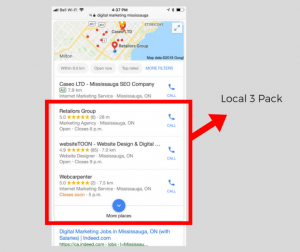
Local 3 pack refers to the maps that show up typically after paid ads and just before search results. Google usually shows the top 3 local businesses that they deem the most relevant based on what someone searched for. Efforts to optimize your online presence and show up on local map results are often referred to as local SEO.
Search engine results on the other hand give searchers a set of links to web pages that Google deems the most relevant to the user’s query. These can be links to company websites or articles posted on blogs. It can even lead to directory listings or even job postings. Once again, Google will deliver the results based on what they feel the user’s intention was when they made their query.
Now that we know what we are trying to accomplish, let’s get to it!
Here are some steps on how to rank a small business on Google:
1) Assess your Current Digital Marketing Presence
Before you start making all of these efforts to rank on Google, you should really take a step back to assess where you currently stand.
Do you have a website? If no, that would probably be a good place to start. We wrote a previous article on how to establish your online presence.
If you do have a website, you need to make sure that it is mobile friendly and that your speed load times are at a good level.
Google provides tools to check these out. Mobile friendly test here, and load time test here.
Why are these important? As stated at the top, Google wants to deliver a good user experience. Fast load times and being able to access your website on a mobile device both equate to good user experience.
Fixing these two areas can make big improvements in how you rank.
Next up, if you are a local business looking to rank on the local 3 pack, let’s make sure you have your Google My Business (GMB) page created and filled out accurately. Create your GMB Page here.
2) On-Page Optimization
Since Google wants to serve up the most relevant results to a search, let’s make sure first off, we are actually delivering the best and most relevant content.
If some of your content is outdated, now would be a good time to update it. Always layout your content to satisfy questions that your potential customer might be asking about your products, services, and even your company.
If you sell multiple products or have various services, it is always best to have separate pages for each one. If for example, you are a mortgage broker, you’ll want to have a separate page for mortgage renewals and another page for equity lines of credit. The idea is to attempt to rank each service separately and cater to a searchers query appropriately.
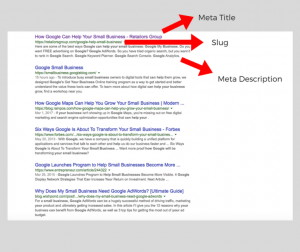
Now that you have your website setup up and ready for search engines to find you, it’s time to optimize the page for Google to better understand what is on it.
There are certain on-page components that Google looks at to better understand what is on this page:
- Slug: This is the URL extension of the page (ie http://yoursite.com/this-is-the-slug)
- Meta Title: this is what Google shows as the title on their search engine results
- Meta Description: this is the description under the title that Google shows on their results
- H1, H2 and other H Titles: These are titles and subtitles found in your content that your visitors will see
- Alt Image Tags: This is a tag that lets Google know what these images on your page is about
- Content: pretty straightforward, your content
- Contact Information using Schema Markup: Schema.org (often called Schema) is a specific vocabulary of tags (or microdata) that you can add to your HTML to improve the way your page is represented in SERPs. (source: https://moz.com/learn/seo/schema-structured-data)
When optimizing your page, you want to make sure there is consistency between your meta title, description, tags, and in your content. Don’t make it spammy!! Find the right balance between designing for your audience and making sure search engines can read it. When stuck, always go with the design for the audience before the search engine.
3) Directory Listing and Social Media Registration
Previously, we stated that you should want to set a goal of ranking in the top three for your business category. We instructed earlier as well to claim or create your Google My Business (GMB) Page, which is what gets listed in the maps for local searches.
Once your GMB page is created and optimized, you want to now be found by both consumers and search engines. In order for Google to confirm who you are, they search the Internet to match up your name, address, and phone number (often referred to as NAP) with as many creditable sources as possible.
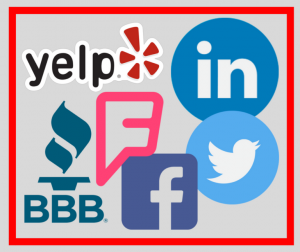
A lot of the creditable sources include popular directories like Yelp, Foursquare, Yellow Pages and Better Business Bureau. It is also good to register local business directories. Google also uses social media sites like Facebook, LinkedIn, Twitter and so on as credible sources to confirm who you are.
As your customers start giving you reviews on these directories and you are staying active on social media with relevant and sharable content, Google will begin to recognize and understand more about you. The better they understand you, the better your chances are of getting listed on the local 3 pack.
4) Link Building
Imagine telling a room full of people that you are a great basketball player. If nobody knows who you are, likely nobody will take you seriously either. But as soon as one or two other people in the room confirm your claim, the more creditable you become. The more creditable you become, the more Google trusts you, and the more likely you will be chosen by Google to be a relevant source.
That is basically what you want to achieve with link building; you want more people to create links pointing back to your website. When Google crawls the Internet and finds all of these links pointing to you, it is the equivalent to my analogy above of people in a room confirming you are the best basketball player.
Now, if your mom is the one confirming you are the best basketball player, you might not gain too much creditability. If Michael Jordan on the other hand confirms your claim, you can be sure that people, including Google, will listen.
So how do we get authoritative sources to link back to your website? That’s an article on its own, but what you do want to focus on is what you are in control of; creating great and sharable content.
Let’s make sure your website has a blog where you can teach and educate people or your product or service. In those blogs, you can create what is called internal links pointing back to relevant areas of your website. Search engines love when they serve up a relevant article that a user reads and continues to click through to links as opposed to hitting the back button on their browser.
In these blogs, give credit where credit is due. If you referenced an idea or took a quote from someone, create a link for them. Good karma will eventually come back your way when others reference your great content.
Share these blogs on social media and make sure your content is search engine friendly. The more people that read your articles, the better chance you get on either converting the user to a customer or getting a backlink to your website.
5) Submit sitemaps to Google and Bing
Both Google and Bing have tools to help them understand more about you. We wrote a guide on Google Search Consoles here. Bing has a similar tool called Bing Webmaster tools.
Basically, these tools allow you to submit a sitemap, which is essentially a list of the pages on your website. You can even speed up the crawling process of your website with these tools.
There are a ton of other resources available on Google Search Console and Bing Webmaster Tools which can help optimize your site and give valuable information like search queries, impressions, click-through-rates, and average position on rankings.
6) Analyze and Make Necessary Adjustments
All of these efforts you make to be found by Google can be exhausting. Worst yet, if you are not making progress, it can be frustrating.
It is crucial that you track your progress and make necessary adjustments. Google provides great tools to make sense of your SEO efforts.
Google Search Console, as mentioned above is a great tool to track everything about search results. Google My Business has a dashboard that gives great insights into how users interact with your GMB page. Google also has an extensive analytics tool, appropriately called Google Analytics, that gives a lot of in-depth information on user behavior and demographics of visitors coming to your website.
There are also a ton of SEO analysis tools available to check out. Relevance.com did a good summary here of 5 of those tools.
As you can see, doing SEO yourself can be daunting but it is totally doable. You don’t need to be an expert or have a bachelor’s degree to rank high on search engines. All you need is time, dedication, consistency, and follow these steps.
About Retailors Group
The team at Retailors Group has over 15 years of retail sales and field marketing experience. Retailors Group takes the time to understand your brand and align your core values into a tailor-made solution that builds a long-lasting relationship with your consumers.
We offer services in Experiential Field Marketing, On-site Sales Assist, Retail Management and Digital Marketing.
Best Times to Post on Social Media for Small Business
Part of your social media marketing strategy is knowing how often you should post on social media. Another part of your social media marketing strategy is knowing the best times to post on social media.
You should post your content on social media when the people you want to see your content are on the network. Posting at the best times on social media will help you get more traffic, more engagement, and more followers.

Here are the best times to post on social media for small business:
1.) Best time post on Facebook: 1-4 PM
The best time to post on Facebook is 1-4 PM late into the week and on weekends. You should post on Facebook on Wednesday at 3 PM, Thursday and Friday at 1-4 PM, and Saturday and Sunday at 12-1 PM.
2.) Best time to Tweet on Twitter: 12-3 PM
The best time to tweet on Twitter is 12-3 PM, with a peak best time at 5PM. You should tweet on Twitter on Monday to Friday at 12-3 PM and 5 PM, except for Wednesday at 12 PM and 5-6 PM.
3.) Best time to Pin on Pinterest: Later at night at 11 PM
The best time to pin on Pinterest is later at night. You should pin on Pinterest on Saturday at 8-11PM and Friday at 3PM.
4.) Best time to post on Instagram: 8-9 AM, 2 AM, and 5 PM
The best time to post on Instagram is throughout the week at 8-9 AM, 2 AM, and 5 PM. You should post on Monday and Thursday at any time other than 3-4 PM, as well as experiment with 2 AM, 5 PM and Wednesday at 7 PM.
5.) Best time to post on LinkedIn: 5-6 PM
The best time to post on LinkedIn is midweek at 5-6 PM. You should post on LinkedIn on Tuesday at 10-11 AM. Tuesday, Wednesday, and Thursday at 7:30-8:30 AM, 12 PM, and 5-6 PM.
6.) Best time to post on Google+: Beginning of the workday morning
The best time to post on Google+ is the beginning of the workday morning. You should post on Google+ on Wednesday at 9 AM and weekdays at 9-11 AM.
When it comes to posting on social media, it is best for you to schedule your post ahead of time. Since social media marketing takes a lot of time and effort to maintain, especially with the amount of posts you have to post on different social media, you can always hire a professional like the Retailors Group for social media management.
Source: https://coschedule.com/blog/best-times-to-post-on-social-media/
About Retailors Group
The team at Retailors Group has over 15 years of retail sales and field marketing experience. Retailors Group takes the time to understand your brand and align your core values into a tailor-made solution that builds a long-lasting relationship with your consumers.
We offer services in Experiential Field Marketing, On-site Sales Assist, Retail Management, and Digital Marketing.
Beginners Guide to Google Search Console
You’ve created an amazing SEO friendly website but can your customers find your business on the web?
One of the first things you need to do after you’ve created a website is to add and verify your site in Google Search Console. Google Search Console is a free service that helps you monitor and maintain your site’s presence in Google Search results.
1.) Add Your Site
So, log into your Search Console account. Then, enter the URL of your site you’re trying to add in the box and click “Add Property.”
That was easy right?
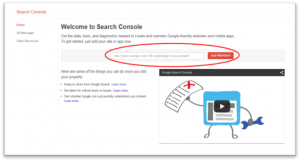
2.) Verify Your Site
Next, you’ll be asked to verify your site. One of the best and easiest ways you can go about this is to add an HTML tag. What you want to do is select “Manage Property,” then “Verify this property.” Click on the “Alternate methods” tab and select “HTML tag” to get the HTML code you’ll need for verification. Copy the HTML code and log into your site’s homepage.
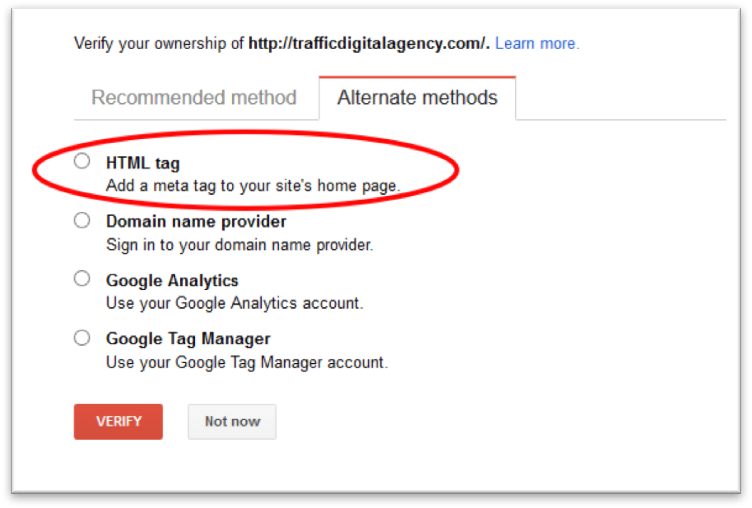
If you’re using WordPress, log into WordPress, and click on “Appearance.” Then, select “Editor” to open your HTML editor for your site’s homepage. Next, click on “header.php” which is located under “Templates” on the right-hand side of your screen. Then, look for the first section of the HTML code in the “header.php” file. Next, paste the HTML code you copied from Google Search Console. Don’t forget to hit “Save” once you have copied the code. Then, go back to your Google Search Console dashboard and click “Verify.”
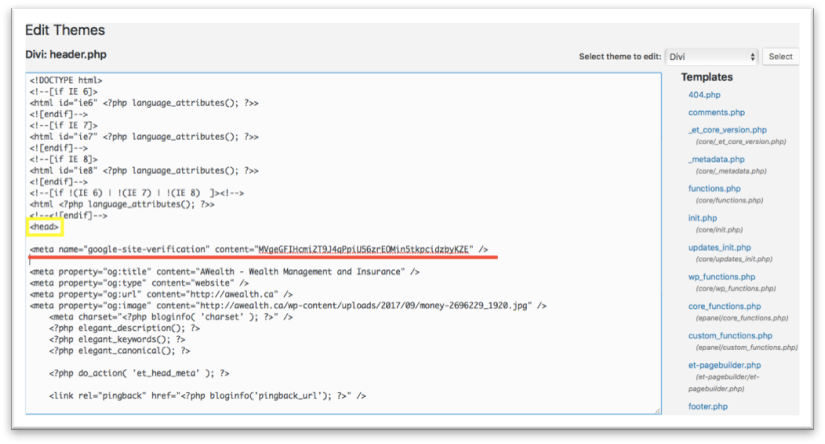
That wasn’t too bad right?
3.) Submit Your Sitemap
Now that you’ve verified your website with Google, the next thing you want to do is to submit a sitemap to Google Search Console. Sitemaps are files that give search engines and web crawlers important information about your site. You’ll be making Google’s job easier by ensuring it has the information needed to do its job more efficiently.
Go back to your Google Search Console dashboard and select your site to submit a sitemap for. On the left-hand side of your screen, click on “Crawl,” select “Sitemaps” and click on “Add/Test Sitemap” in the upper right-hand corner. This will bring up a box with a space to add text to it.

Related Article: How Google Can Help Your Small Business
Open a new tab and type in yourdomainname.com/sitemap.xml to get your XML sitemap. What you want to do is copy everything after https://yourdomainname.com. Then, go back to your Google Search Console and paste the sitemap on the box with a space to add text to it and click “Submit Sitemap.”
Okay so are you still with me? There’s still one more thing left!
4.) Fetch as Google and Submit to Index
Say you’ve made changes to your website. For example, you updated your on-page content. You’d want this to appear in search results as soon as possible. And, if you want Google to get the updates indexed, you’ll have to submit it manually.
Go back to your Google Search Console dashboard, click on “Crawl” and click on “Fetch as Google.” This should bring you to a screen that looks like this:

If you updated your whole website, you’d want to leave the center box blank. If you only updated a page on your website, entire the full address of the page you need indexed. Once you enter the page you need to be indexed, click the “Fetch and Render” button. Next, click on “Request indexing” and open up a box that will give you the option to either “Crawl Only This URL” or “Craw This URL and its Direct Links.
If you are fetching a specific page, choose “Crawl Only This URL.” If you are fetching your entire site, choose “Crawl This URL and its Direct Links,” Then, wait for the indexing to complete. Changes should appear in Google in a couple of days!
Source: https://moz.com/blog/a-beginners-guide-to-the-google-search-console
About Retailors Group
The team at Retailors Group has over 15 years of retail sales and field marketing experience. Retailors Group takes the time to understand your brand and align your core values into a tailor-made solution that builds a long-lasting relationship with your consumers.
We offer services in Experiential Field Marketing, On-site Sales Assist, Retail Management and Digital Marketing.
Best Practices for Your AdWords Campaign
You’ve created an amazing SEO friendly website but can your customers find your business on the web?
One of the first things you need to do after you’ve created a website is to add and verify your site in Google Search Console. Google Search Console is a free service that helps you monitor and maintain your site’s presence in Google Search results.
1.) Add Your Site
So, log into your Search Console account. Then, enter the URL of your site you’re trying to add in the box and click “Add Property.”
That was easy right?

2.) Verify Your Site
Next, you’ll be asked to verify your site. One of the best and easiest ways you can go about this is to add an HTML tag. What you want to do is select “Manage Property,” then “Verify this property.” Click on the “Alternate methods” tab and select “HTML tag” to get the HTML code you’ll need for verification. Copy the HTML code and log into your site’s homepage.

If you’re using WordPress, log into WordPress, and click on “Appearance.” Then, select “Editor” to open your HTML editor for your site’s homepage. Next, click on “header.php” which is located under “Templates” on the right-hand side of your screen. Then, look for the first section of the HTML code in the “header.php” file. Next, paste the HTML code you copied from Google Search Console. Don’t forget to hit “Save” once you have copied the code. Then, go back to your Google Search Console dashboard and click “Verify.”

That wasn’t too bad, right?
3.) Submit Your Sitemap
Now that you’ve verified your website with Google, the next thing you want to do is to submit a sitemap to Google Search Console. Sitemaps are files that give search engines and web crawlers important information about your site. You’ll be making Google’s job easier by ensuring it has the information needed to do its job more efficiently.
Go back to your Google Search Console dashboard and select your site to submit a sitemap for. On the left-hand side of your screen, click on “Crawl,” select “Sitemaps” and click on “Add/Test Sitemap” in the upper right-hand corner. This will bring up a box with a space to add text to it.

Related Article: How Google Can Help Your Small Business
Open a new tab and type in yourdomainname.com/sitemap.xml to get your XML sitemap. What you want to do is copy everything after https://yourdomainname.com. Then, go back to your Google Search Console and paste the sitemap on the box with a space to add text to it and click “Submit Sitemap.”
Okay so are you still with me? There’s still one more thing left!
4.) Fetch as Google and Submit to Index
Say you’ve made changes to your website. For example, you updated your on-page content. You’d want this to appear in search results as soon as possible. And, if you want Google to get the updates indexed, you’ll have to submit it manually.
Go back to your Google Search Console dashboard, click on “Crawl” and click on “Fetch as Google.” This should bring you to a screen that looks like this:

If you updated your whole website, you’d want to leave the center box blank. If you only updated a page on your website, entire the full address of the page you need indexed. Once you enter the page you need to be indexed, click the “Fetch and Render” button. Next, click on “Request indexing” and open up a box that will give you the option to either “Crawl Only This URL” or “Craw This URL and its Direct Links.
If you are fetching a specific page, choose “Crawl Only This URL.” If you are fetching your entire site, choose “Crawl This URL and its Direct Links,” Then, wait for the indexing to complete. Changes should appear in Google in a couple of days!
Source: https://moz.com/blog/a-beginners-guide-to-the-google-search-console
About Retailors Group
The team at Retailors Group has over 15 years of retail sales and field marketing experience. Retailors Group takes the time to understand your brand and align your core values into a tailor-made solution that builds a long-lasting relationship with your consumers.
We offer services in Experiential Field Marketing, On-site Sales Assist, Retail Management and Digital Marketing.
3 Ways to Boost SEO on Your WordPress Site
As a small business owner, I hope you have a website. Because if you don’t, then you’re missing out. You’re missing out on the opportunity for your customers to find you on search engines, which means your competitors that have websites are taking business away from you. It’s important to get a website and develop your online presence; the longer you push this aside, the longer it will take for you to be found.
Related Article: Establishing your Online Presence as a New Business Owner
If you HAVEN’T created a website for your business. One of the most popular platforms is a WordPress site. Many celebrities, news outlets, famous blogs, and Fortune 500 companies are using WordPress.
Websites are important to your business. Yeah, you’ve put information about your business like your hours of operation and where you’re located. Yeah, you’ve chosen a great template and the right images to make it look pretty and appealing for customers. But, how are search engines like Google going to help your customers find you? You’re going to need to boost SEO (search engine optimization) on your WordPress site.
Here are three ways you can boost the SEO of your WordPress site:
1. INSERT A TITLE TAG
This is the most important tag when it comes to increasing your rankings on search engines. For search engines like Google to rank your site, it needs to know three things which are: what your content is about, what each page is about, and what your site as a whole is about.
![]()
The keywords that you target with your content need to be in your title tag. In order to do this for your WordPress website:
1. Go to your WordPress dashboard
2. Click on “Posts.”
3. Select the post you’d like to add a title tag to.
4. Type in what you want as your title tag where the post says “Enter title here.”
2. INSERT A META DESCRIPTION TAG
Below the title, there’s a meta description. A meta description is information that describes what the content is about. There should be continuity between your title tag and your meta description.
Related Article: Quick SEO Guide for Small Businesses
![]()
As you can see, the focus keywords for the title tag are also in the meta description, “Experiential Field Marketing.” This makes it easier for a search engine to recognize what you’re talking about which will help you rank well.
In order to do this for your WordPress site:
1. Go to the post where you want to add a meta description. On the right side, you’ll see a box that says “SEO Description.”
2. Type a meta description that includes your target keyword.
3. INSERT IMAGE ALT TAGS
Don’t forget to ignore your images! Just remember that people don’t only search in Google under the “All” tab. There are some people that will also search under the “Images” tab. Therefore, you need to include alt tags on all of your images.
In order to do this for your WordPress site:
1. Go to the post with an image. Click on the image and you’ll see this bar.
2. Click on the pencil.
3. On the side, you’ll see an empty box that’s labeled “Alt text.” Type something that describes what the image is about.
After completing these steps to boost SEO, you will be in a better position to be found by search engines.
About Retailors Group
The team at Retailors Group has over 15 years of retail sales and field marketing experience. Retailors Group takes the time to understand your brand and align your core values into a tailor-made solution that builds a long-lasting relationship with your consumers.
We offer services in Experiential Field Marketing, On-site Sales Assist, Retail Management, and Digital Marketing.
Organic Search vs Paid Search: What is the Difference?
Say you’re looking to buy a house and you need a mortgage broker. What do you do? Some of us will ask our family or friends for advice. Some of us will use a search engine like Google.
Search engines like Google have become the solution to a lot of our problems. You can’t even deny it, you use Google for everything! Whether you’re looking for a mortgage broker or looking for how to cook a steak, Google is usually the first place we turn to.

But, Google is also important to businesses. As a small business owner, you should take advantage of Search Engine Optimization (SEO, also known as organic search) and Search Engine Marketing (SEM, also known as paid search). You can generate more traffic and leads to your business with the help of SEO and SEM.
What is Organic Search?
Now, say you’re the mortgage broker and a potential client is out there looking for you. He or she has typed into Google “Mortgage Brokers, Mississauga.” How do you expect this person to find you? Have you claimed your Google My Business listing? Do you have a website that will direct people to you? Your potential client will see a list of links that appear below the ads. These links are known as “organic” or “non-paid” search engine results.
Do you want to achieve the best organic results?
You must keep in mind a few things about SEO:
1. Optimize your website’s usability and appearance
2. Create original and shareable content that is informative and captivating
3. Use the right keywords and position your keywords strategically
You must also keep in mind that SEO takes time to develop. Remember, you are trying to rank on Google using organic or non-paid search engine results. How long are you willing to wait to see results? Because it may take months or years to get high rankings on Google. Just think of your SEO initiative like growing a green and healthy lawn. Your lawn needs some “TLC” on a regular basis such as watering it and using natural fertilizers rather than pesticides.
Benefits of Organic Search
So, SEO takes time. But, is it worth it? The answer is yes. Approximately 70% of the links users click on when they search are organic. What does this mean for you and your business? Well, high search engine rankings mean you’ve built trust and credibility, which equals to a greater likelihood of users to click through to your site.
What is Paid Search?
Paid search or SEM is referred to as paid listings. These are the list of links you will see that appear above the organic or non-paid search engine results. The most popular advertising service used by businesses is Google’s advertising system called Google AdWords. Google AdWords is where you bid on relevant keywords so your ads can appear on Google’s search results.
How does Google AdWords work?
In Google AdWords, the actual position of your ad is determined by your ad rank (Maximum Bid times Quality Score). Therefore, the highest ad rank gets the first ad position. So, your Cost-Per-Click (CPC) is determined by the ad rank of the highest ad below you divided by your Quality Score (QS). However, you will pay for your maximum bid-per-click when you are the only bidder or the lowest bid in the AdWords auction.
One of the most important things to keep in mind is that AdWords bidding PENALIZES advertisers who bid with a low QS.
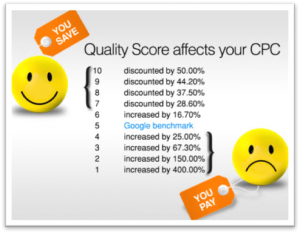
Does Google AdWords work?
AdWords may or may not work for your business. It is dependent on the competitiveness of the keywords you’re bidding for and the ratio of relevancy to conversions for your business. AdWords can be EFFECTIVE if you’re bidding on the right keywords. You can use Google Keyword Planner to help you identify the right keywords to target and to find which keywords your competitors are using.
Benefits of Paid Search
We know that SEO takes time, but what about SEM then? Paid search engine results are placed on top of rankings as soon as you pay for ad placement in Google AdWords. You can also tailor your Pay-Per-Click (PPC) campaigns to reach specific audiences. Some examples of segmentation include age, income, and marital status.
Related Story: How Google Can Help Your Small Business
Which One is for Me?
Should I use organic search or paid search? Which one is better to use? Should I be using both? The truth is that it depends. The answer is dependent on the type of business you have and the objectives of your business. Here at Retailors Group, we believe together is better. The combination of both organic search and paid search is the best approach.
Just remember this… Organic search provides you with trust and credibility which equals a greater likelihood of users to click through to your site. Paid search provides you immediate listings using the right keywords and reaches specific audiences. And with paid search, you’re pushing your business to customers. Wouldn’t you want the best of both worlds for your business?
About Retailors Group
The team at Retailors Group has over 15 years of retail sales and field marketing experience. Retailors Group takes the time to understand your brand and align your core values into a tailor-made solution that builds a long-lasting relationship with your consumers.
We offer services in Experiential Field Marketing, On-site Sales Assist, Retail Management, and Digital Marketing.
Sources
Image 1: http://blogoscoped.com/archive/2004_10_31_index.html#109922219137420342
Image 2: http://hubshout.com/?Three-of-the-Most-Convincing-Statistics-All-SEO-Resellers-Need-to-Know&AID=1645
Image 3: http://www.wordstream.com/quality-score
How Google Can Help Your Small Business
Google is the most used search engine in the world. But, did you know Google does a lot more than just searches? Google offers a ton of tools for your small business in addition to its search engine.
You should be taking full advantage of all Google has to offer. Here are some of the best ways Google can help your small business:
1. Google My Business
Do you want FREE advertising on Google? Well, all you have to do is claim your Google My Business listing. When customers search for your business or businesses like yours, Google My Businesses helps you to get found on Google Search and Maps. Below is an example of local Google My Business results for the search “Italian restaurants, Toronto.”

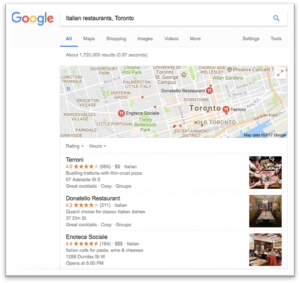
2. Google AdWords
So you have tried an organic search, but you want it to rank in Google Search. Google AdWords is Google’s pay-per-click (PPC) product which helps you to create ads that target specific keywords to your business. PPC ads appear above the organic search results on Google. Below is an example of local Google AdWords results for the search “Field Marketing, Mississauga.”
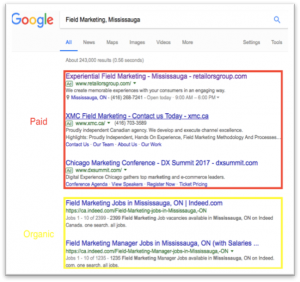
Related Article: Establishing your Online Presence as a New Business Owner
3. Google Keyword Planner
Google Keyword Planner is a tool meant to help your Google AdWords efforts. However, if you are looking to boost your organic search, Google Keyword Planner helps you with your Search Engine Optimization (SEO) efforts by identifying keywords to target. The keywords you select is just as valuable as the content you create when it comes to SEO. This is important because if Google cannot find your site, you’re missing out on opportunities to drive traffic to your business.

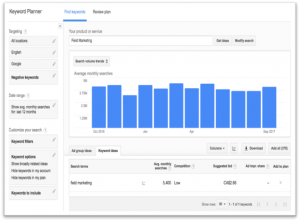
4. Google Search Console
As a small business owner, you probably have a website but, can your customers find you on the web? Google Search Console helps you monitor and maintain your site’s presence in Google Search results. The best part about it is that it’s FREE and you don’t have to sign up for Search Console for your site to be included in Google’s search results.


Related Article: Quick SEO Guide for Small Businesses
5. Google Analytics
One of the most popular web analytics tools is Google Analytics. This is an important tool for monitoring and analyzing traffic on your website from SEO and SEM initiatives. According to Google, Google Analytics “helps you analyze visitor traffic and paint a complete picture of your audience and their needs, wherever they are along the path to purchase.”

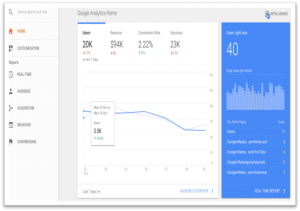
About Retailors Group
The team at Retailors Group has over 15 years of retail sales and field marketing experience. Retailors Group takes the time to understand your brand and align your core values into a tailor-made solution that builds a long-lasting relationship with your consumers.
We offer services in Experiential Field Marketing, On-site Sales Assist, Retail Management, and Digital Marketing.
Establishing your Online Presence as a New Business Owner
Deciding to venture off and be a new business owner is an exciting time. Albeit exciting, any existing or new business owner knows that the first stage of opening your new business is tough, painful, risky, requires long hours, and can be stressful at times.
You are trying to get your business off the ground and you start to realize that prioritizing your time will be a challenge. Where do you spend your time? Is it in business development? Maybe you should set up a good accounting system to avoid future pains, or maybe you should spend some time hiring because getting the right people at this stage is key.
Getting caught up in the whirlwind of necessary activities leaves very little time for important but non-urgent activities. We all fall for it. Establishing your online presence as a new business owner at the beginning stages is crucial to have long term success.
Below you will find some items to do in order to establish your online presence as a new business owner.
Get a website

Don’t push it aside for later. It takes time to develop your online presence and the longer you push this aside, the longer it will take for you to be found.
Nearly 50% of small businesses in Canada do not have a website. Here is what they are missing out on:
- 95% of consumers use search engines to find local businesses. Appearing on popular search engines like Google is directly associated with your website. (Source: searchengineland.com)
- Your website is open 24 hours a day, 7 days a week to provide information to your consumers
- Businesses that do not have a website lack credibility. If a potential consumer wants to know more about you but can’t find you online, they might second guess doing business with you.
- Competitors that have websites are taking business away from you
I’m sure there are a dozen or more reasons why you need a website, but we’ll save that for another day.
Related Article: Quick SEO Guide for Small Businesses
Create high-quality content on your website

When the Internet first came about and businesses were creating websites, they treated them more like an online brochure. It was effective back in the day but now websites are best utilized for more than just who you are and what you offer.
You’ve probably heard this before, but here it is again, content is king.
Having a section on your website for a blog or original articles tailored to your audience will allow you to create a community of people that will keep coming back for more.
Small businesses with blogs get 126% more lead growth than small businesses without.
Let’s not forget the benefits of Google loving relevant content and making it available for searchers to find giving you even more people that know people to join your community. The organic momentum from this compound to something greater than you could have ever imagined.
Get on social media

Social media is not just about liking pictures and entertaining yourself. If you’re a small business owner, there are a variety of reasons to get onto social media.
A staggering 67% of the population in Ontario, Canada use social media. Those that use Facebook specifically spend on average 40 minutes a day on this social platform.
Outside of the large audience, having a social media presence helps with brand awareness, loyalty, and authority. Consumers and search engines will establish more trust behind your brand when you’re available on social media.
Similar to your website, having a presence on social media isn’t just about showcasing who you are and what you do. Remember that cool content that you are producing on your website? Share it on social media! Your reach will now exponentially increase.
Related Article: 7 Reasons Social Media Marketing is Still Underrated
Being available on social also gives you the opportunity to improve your customer service. Giving consumers a platform to express delights and frustrations gives you, the business owner, a chance to show gratitude and gain valuable feedback. Those that are upset will allow you to try and turn an unhappy customer into a happy one.
There is quite a bit of platform you can choose to establish your social media presence. Don’t try to get on every platform. Find what works for you and your industry and stay active. It’s better to have one social media account and be hyperactive vs being on 4 and not being active.
Register your company and website on business directories

Staying consistent with various points made in this article, registering on online business directories helps to further increase your online presence.
Ultimately, you want to be found online and there are a plethora of directories that you can register on. There are free ones and paid ones, so do your due diligence on finding the right one for your business. Here is a good list of online directories to check out.
Once you establish your website and social media accounts with relevant content you can point these sources to these directories. In turn, these directories will work on your behalf to point consumers to you.
You will now be accessible, visible, and reputable once you tie all of these components together.
Remember, getting your online presence may seem non-urgent but it is very important. It is a lot of hard work that requires nurturing in order to develop but the rewards will be well worth the time.
About Retailors Group
The team at Retailors Group has over 15 years of retail sales and field marketing experience. Retailors Group takes the time to understand your brand and align your core values into a tailor-made solution that builds a long-lasting relationship with your consumers.
We offer services in Experiential Field Marketing, On-site Sales Assist, Retail Management, and Digital Marketing.

